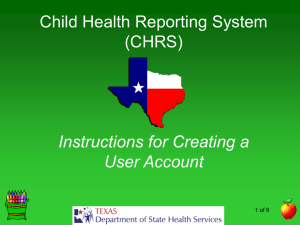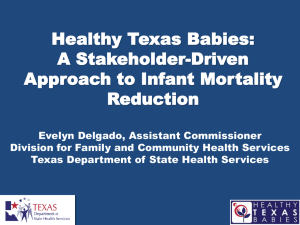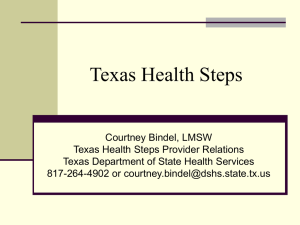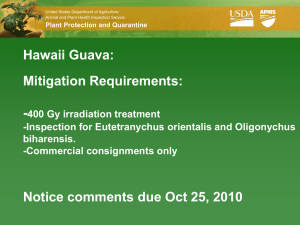Overview of Public Health Law in Texas
advertisement
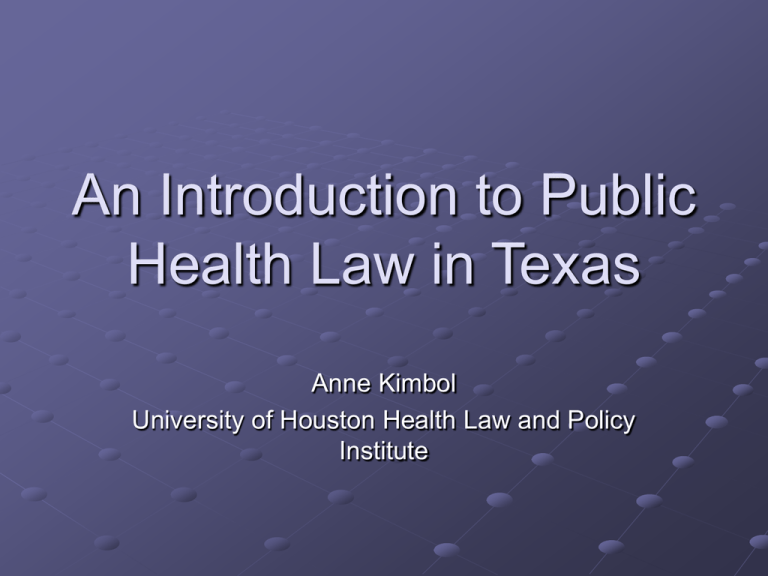
An Introduction to Public Health Law in Texas Anne Kimbol University of Houston Health Law and Policy Institute What is Public Health Law? Intersection between public health professionals and government/regulation Largely deals with authority and the balance between the need to protect the public health and individuals’ rights Authority in Texas - Federal Police powers v. Commerce Clause. President – communicable disease definition Secretary of HHS/CDC – regulations relating to communicable diseases and help states Authority in Texas - Governor Texas Disaster Act Evacuations Emergency management plan Authority in Texas - DSHS Implementation of communicable disease control measures Declare public health disaster Define reportable diseases Help/preempt local authorities Investigate cases Authority in Texas - Local Local health authority is in charge of control measures locally and most communication between locals and DSHS Authority generally overlaps with DSHS but with area limitations For certain actions, LHA must consult DSHS Authority in Texas - Courts Courts largely play a role of ensuring adequate balance between public safety and individual rights Mostly get involved when a party refuses to comply with an order from the LHA or DSHS Reportable Diseases - Who? Dentists Vets Local school authorities Person in charge of clinical or hospital lab, blood bank, mobile unit, or other facility performing labs RN Administrator or director of nursing home, personal care home, maternity home, adult respite care center, adult day-care center, home health agency, institution of higher ed, public or private camp, home, or institution, correctional institution Owner or manager of restaurant, dairy, other good handling or processing place EMT Peace officer Firefighter Reportable Disease – What And When? Defined by DSHS http://www.dshs.state. tx.us/idcu/investigatio n/conditions/ Additional organisms Information to be reported Reportable Diseases - Animals Multiple species diseases Akabane - Akabane virus Anthrax** - Bacillus anthracis Aujeszky’s disease - Pseudorabies virus, herpesvirus suis Leishmaniasis** - Leishmania infantum and L donavani Foot and mouth disease - Aphthovirus, types A,O,C, SAT, Asia Heartworm - Cowdria ruminantium African Trypanosomosis (Nagana) - Trypanosoma brucei, T. vivax, T. brucei Rinderpest - Morbillivirus Rift Valley fever - Bunya virus Vesicular stomatitis - Rhabdovirus; 2 serotypes; New Jersey and Indiana Screwworm - Cochliomyia hominivorax Cattle diseases (including Exotic Bovidae) Bovine babesiosis - B. bovis, B. divergens, Babesia microti Bovine brucellosis - Brucella abortus Bovine ephemeral fever - Rhabdovirus Bovine tuberculosis - Mycobacterium bovis East coast fever (Theileriosis) - Theileria parva Malignant catarrhal fever (wildebeest associated) – Alcelaphine herpesvirus (AHV 1) Contagious bovine pleuropneumonia - Mycoplasma mycoides Lumpy skin disease - Neethling poxvirus Bovine spongiform encephalopathy Scabies - Sarcoptes scabiei, Psoroptes bovis, Chorioptes bovis Reportable Diseases - Animals Cervidae Brucellosis - Brucella abortus, Brucella suis (biotype 4) Chronic Wasting Disease Tuberculosis - Mycobacterium bovis Sheep and goat diseases Caprine and ovine brucellosis (not B. ovis infection) - Brucella melitensis Contagious caprine pleuropneumonia - Mycoplasma capri (biotype 78) Louping ill - Flavovirus Nairobi sheep disease - Bunyaviridae Peste des petits ruminants - Morbillivirus, Paramyxoviridae family Sheep pox and goat pox - Capripoxvirus Scrapie Scabies - Sarcoptes scabiei Equine diseases African horse sickness - Orbivirus Contagious equine metritis - Tayorella equigenitalis Dourine - Trypanosoma equiperdum Epizootic lymphangitis - Histoplasma farciminosum Equine encephalomyelitis (Eastern and Western)** - Alphavirus Equine infectious anemia - Lentivirus Equine morbillivirus pneumonia - Morbillivirus Equine piroplasmosis - Babesia equi, B. caballi Glanders - Pseudomonas mallei Japanese encephalitis - Flavovirus Surra - Trypanosoma evansi Venezuelan equine encephalomyelitis** - Alphavirus; Togaviridae family Equine Viral Arteritis (EVA)* *** Equine Herpes Virus-1 (EHV-1)* Reportable Diseases - Animals Swine diseases African swine fever - Poxvirus Classical swine fever (hog cholera) - Togovirus Pseudorabies - Herpesvirus suis Porcine brucellosis - Brucella suis Swine vesicular disease - Picornavirus Vesicular Exanthema - Calicivirus Poultry diseases Avian influenza - Orthomyxoviruse Avian infectious laryngotracheitis - Orthomyxovirus, herpesvirus Avian tuberculosis - Mycobacterium avium serovars 1,2 Duck virus hepatitis - Picornavirus Duck virus enteritis - Herpesvirus Fowl typhoid - Salmonella gallinarum Highly pathogenic avian influenza (fowl plague) - Orthomyxovirus (type H5 or H7) Infectious encephalomyelitis - Arbovirus Ornithosis (psitticosis) - Chlamydia psittaci Pullorum disease - Salmonella pullorum Newcastle disease (VVND) - Paramyxovirus-1 (PMV-1) Paramyxovirus infections (other than Newcastle disease) - PMV-2 to PMV-9 Rabbit diseases Myxomatosis - Myxomatosis virus Viral haemorrhagic disease of rabbits - Calciviral disease *These diseases will only be reportable through the last day of the 81st Texas Legislative Session unless continued in effect by act of the legislature. **These diseases are also reportable to the Department of State Health Services (DSHS) ***This disease has reporting standards in Chapter 49, §49.4 of this title (relating to Equine Viral Arteritis (EVA): Reporting and Handling for Breeding of Infected Equine). Reportable Diseases – Where? To DSHS or Local Health Authority Local Health Authority must report to DSHS Texas Animal Health Commission Reportable Diseases – Why? Tracking Class B Misdemeanor Liability protection for good faith reporting Protection of those handling dead bodies Communicable Diseases - Schools LHA may close school if needed to protect public health Exclusionary conditions Amebiasis Campylobacteriosis Chickenpox Amebiasis Common cold Conjunctivitis, bacterial and/or viral Fever Fifth disease Gastroenteritis Giardiasis Head lice Hepatitis A Impetigo Infections mononucleosis Influenza Measles Meningitis bacterial Mumps Whopping cough Ringworm Rubella Salmonellosis Scabies Shigellosis Streptococcal sore throat and scarlet fever – until antibiotic treatment has begun and physician certificate or health permit is obtained Quarantine and Isolation - Terms Quarantine Not defined in Texas H&S Code PH definition – Separation and restriction of movement of individuals who are not yet ill but have been exposed to a communicable disease Isolation Also not defined in law Separation of individuals ill with a communicable disease Terms are often used interchangeably in law Quarantine and Isolation - Property Quarantine of Property (Texas Health & Safety Code §§ 81.063-065, 067-068, 084, 087-088) Suspect property is infected or contaminated Failure to comply is a Class B misdemeanor Provide notice to owner and quarantine property Class B misdemeanor to knowingly remove, conceal, or dispose of property under investigation Take samples for testing; offer similar samples to the owner Class A misdemeanor to refuse entry or inspection Determine appropriate control measures If no appropriate control measures exist, require owner to destroy property. If land, require secure fencing and sealing off of all structures Release quarantine if no contamination or infection found Release quarantine when safe Q&I – Property - DSHS Right of entry Samples Impose control measures Quarantine Restrict access Destruction Q&I – Property – LHA Same as DSHS within region Q&I – Property – Courts Penalties Enforcement Quarantine and Isolation - Carriers Actions Involving Carrier or Private Conveyances (Texas Health & Safety Code §§ 81.086, 089) Vehicle or craft in Texas Reasonable cause to believe it traveled through or from an area infected or contaminated by a communicable disease Determine control measures and issue related order – order vehicle stopped and obtain information on the passengers and cargo Owner may be ordered to pay costs of any technically feasible control measures Release Knowingly transporting infected or contaminated people or property is a Class A misdemeanor; if intent to cause harm or defraud then felony of the third degree Q&I – Carriers - DSHS Order the vehicle stopped Get information on people aboard Impose control measures Q&I – Carriers – LHA Same as DSHS Q&I – Carriers - Courts Penalties Enforcement Quarantine and Isolation - Areas Area Quarantines (Texas Health & Safety Code § 81.085) Issue area quarantine order upon reasonable cause to believe persons or property contaminated (if HA, must consult with DSHS and give notice to impacted governing bodies) If needed, cooperative agreements with neighboring states Publish notice in newspaper of general circulation each week Use other reasonable means to communicate with persons in the area of the quarantine and needed actions If needed, request disclosure of individuals’ immunization records and take any appropriate action If needed, commissioner’s court of affected county or governing body of municipality or hospital district may suspend admission of patients seeking elective treatment; does not impact responsibilities to indigent residents Termination by DSHS (HA may only terminate with DSHS consent ) Failure to comply with area quarantine and related orders is a felony of the third degree Q&I – Areas – DSHS Quarantine Investigations Work with neighboring states Publish notice Obtain immunization records Q&I – Areas – LHA Quarantine after DSHS consult Written notice Governing body Public Designate facilities Q&I – Area – Courts Penalties Enforcement Suspend admission of patients seeking elective treatment Quarantine and Isolation - People Quarantine Process – Individual (Texas Health & Safety Code §§ 81.066, 082-083, 151-199) Diagnosis and Reporting Implementation of control measures by health authority or department by means of written orders . (Delivery and non-compliance with HA or DSHS order not required during disaster.) Violation of orders Compliance with Orders Seek court-ordered treatment (Person may make religious objection unless there is a proclaimed disaster , public health emergency, or area quarantine; in which case seek only protective custody) Criminal Penalty – Class B Misdemeanor Motion for order for temporary protective custody ; must allege: 1. Application for an order for protective custody and an application for a court order for management of a person with a commun icable disease will be filed the next business day ; and 2. There is probable cause to find a substantial risk of serious harm without the order . Order for temporary protective custody 1. Terminates by 4 p.m. the following business day. Termination delayed to allow court to rule if applications for an order for protective custody and for a court order for management of a person with a communicable disease have been filed . 2. Order is issued based on representations in the court filings and not an adversary hearing . Person remains free pending order for protective custody and /or court for management if TPC order not granted . Motion for Order for Protective Custody; must allege: 1. Person meets all criteria for commitment ; and 2. Person presents immediate threat to the public health . Application for court order for management of person with a communicable disease ; must contain: 1. Person’s name and address; 2. Person’s county of residence; 3. Person is infected with communicable disease ; 4. Copy of written order; 5. Medical evaluation Appointment of attorney within 24 hours of application Apprehension and detention under court order Hearing within 14 days (cannot be held within first 3 days if person or attorney objects; good faith continuances allowed but hearing must be held within 30 days) Appointment of attorney Notice to appropriate parties Probable cause hearing within 72 hours of detention (delay allowed if location of person or court is in a public health disaster). Disclosure of information/document to person’s attorney Recommendation of treatment and designation of facility by health authority or department (eligible facilities designated by Commissioner of Health ) Hearing on application Order for continued detention (requires finding of risk of serious harm to self or others). Court-ordered outpatient services Release Order for release Motion for modification order Order for temporary management (1-90 days) Order for extended management (90 days – 1 year) Appeal or rehearing Compliance with order Order for temporary detention pending modification Motion denied Designation of facility Modification of order for outpatient treatment Person released Appeal Modification upheld Compliance with order, including transportation to facility and acknowledgement of delivery Quarantine and Isolation - People Quarantine Process – Group of 5 or more (Texas Health & Safety Code §§ 81.066, 082-083, 151-199) Diagnosis and Reporting Implementation of control measures by health authority or department by means of written orders . (Delivery and non-compliance with HA or DSHS order not required during disaster.) Violation of orders Compliance with Orders Seek court-ordered treatment; statements in application should be based on group actions (Person may make religious objection unless there is a proclaimed disaster, public health emergency, or area quarantine; in which case seek only protective custody) Criminal Penalty – Class B Misdemeanor Motion for order for temporary protective custody; must allege: 1. Application for an order for protective custody and an application for a court order for management of a group with a communi cable disease will be filed the next business day; and 2. There is probable cause to find a substantial risk of serious harm without the order . Order for temporary protective custody 1. Terminates by 4 p.m. the following business day. Termination delayed to allow court to rule if applications for an order for protective custody and for a court order for management of a group with a communicable disease have been filed . 2. Order is issued based on representations in the court filings and not an adversary hearing . Group remains free pending order for protective custody and/or court for management if TPC order not granted. Motion for Order for Protective Custody; must allege: 1. Group meets all criteria for commitment; and 2. Group presents immediate threat to the public health. Application for court order for management of group with a communicable disease; must contain: 1. Description and location of group; 2. Narrative on how group was exposed or infected; 3. Estimate on number in group; 4. Names, addresses, and counties of residence if known (if not known statement of how sought and why unknown); 5. Statement that the members failed to comply with control measure orders; and 6. Medical evaluation of group – may be based on individual evaluation if doctor believes it to be representative of the group. Appointment of attorney within 24 hours of application; one for group is fine unless anyone requests an individual attorney Apprehension and detention under court order Hearing within 14 days (cannot be held within first 3 days if group or attorney objects; good faith continuances allowed but hearing must be held within 30 days) Appointment of attorney Notice to appropriate parties Probable cause hearing within 72 hours of detention (delay allowed if location of group or court is in a public health disaster). Disclosure of information/document to group’s attorney(s) Recommendation of treatment and designation of facility by health authority or department (eligible facilities designated by Commissioner of Health ) Hearing on application Order for continued detention (requires finding of risk of serious harm to selves or others). Court-ordered outpatient services Release Order for release Motion for modification order Order for temporary management (1-90 days) Order for extended management (90 days – 1 year) Appeal or rehearing Compliance with order Order for temporary detention pending modification Motion denied Designation of facility Modification of order for outpatient treatment Group released Appeal Modification upheld Compliance with order, including transportation to facility and acknowledgement of delivery Q&I – People – DSHS Preempt LHA Return other states’ residents Impose control measures Individuals Groups Q&I – People – LHA Same as DSHS Q&I – People – Courts Penalties Different types/levels/procedures for enforcement Order for Management of Person with a Communicable Disease Temporary Extended Protective Custody Orders Q&I – People – Courts – PCO Motion for Order for temporary protective custody Order for TPC Motion for Order for Protective Custody Attorney Probable Cause hearing Court order – continued detention or release Q&I – People – Courts – OMPCD Application Appointment of attorney Timing Notice Recommendations Hearing Court decision – release, outpatient, temporary, extended Q&I – People – Modifications Cause Notice Hearing Detention Counsel Court decision Q&I – People – Renewal For extended management order Application Affidavit Attorney Hearing Q&I – People – Rehearings Rehearing Appeal Examination Timing Q&I – People – Treatment Facility Temporary Passes Release/discharge Q&I – People – Groups Any statement or determination regarding the conduct of a member of the group must apply to the majority of its members; Any finding or statement regarding compliance must apply to all members of the group; Any notice being sent to the group must also be published in the local newspaper of general circulation, state that the group is appointed one attorney but any individual member may request an individual attorney, and include instructions for people who suspect they may be part of the group to contact DSHS or the LHA. Rabies A reportable condition in humans and animals For animals Report within one working day of diagnosis for animal Report to regional zoonosis control office of Zoonosis Control Division in Austin For humans – report immediately to LHA or DSHS regional director (considered public health emergency) Rabies – DSHS H&S Code Chapter 826 Set minimum standards Provide vaccine or serum Adopt control measure rules Hold hearings Regulate facilities Override locals Rabies – Local/Professionals Local rabies control authority Animal licensing Quarantine and other control measures Liability protection for veterinarians Exemptions for police dogs Penalties for facilities Rabies biologicals Rabies – Individuals Vaccinate cats and dogs Penalties for failure Reporting of suspected rabies and/or possible transmission to humans Rabies – Area Quarantines Area quarantine if rabies exists in an area Borders and rules adopted Restraint provisions Penalty for failure to comply Contact Information; Other UH Health Law and Policy Institute will be releasing a bench book for judges on isolation and quarantine issues. Will include charts shown here as well as sample forms and simplified language summarizing the key statutes. Anne Kimbol, askimbol@central.uh.edu, 713-743-2198 Further Contacts/Information FEDERAL Centers for Disease Control and Prevention (800) CDC-INFO Federal Emergency Management Agency (800) 621-FEMA National Institutes of Health (301) 496-4000 Office of the Surgeon General (301) 443-4000 Public Health Service Commissioned Corps (240) 453-6000 STATE Commissioner of Health (888) 963-7111 Governor’s Office (800) 843-5789 Office of General Counsel, TDSHS (512) 458-7236 Office of Public Health Practice, TDSHS (512) 458-7700 Center for Public Health Preparedness and Response, TDSHS (512) 458-7219 Further Contacts/Information SUGGESTED LOCAL CONTACTS County Commissioners’ Court County and/or municipal departments of health City Council City Attorney’s Office Local office of public health preparedness County Attorney County Appraisal District Information Available on the Internet Centers for Disease Control and Prevention http://www.cdc.gov/ Federal Emergency Management Agency http://www.fema.gov/ National Institutes of Health http://www.nih.gov/ Governor’s Office http:///www.governor.state.tx.us Texas Department of State Health Services http://www.dshs.state.tx.us Communicable Disease Control Measures in Texas, DSHS Report http://www.dshs.state.tx.us/comprep/ogc/cdmanual.pdf Avian Flu Pandemic Litigation Forms, Office of the Attorney General http://www.oag.state.tx.us/notice/emergency /birdflu/index_forms.php


